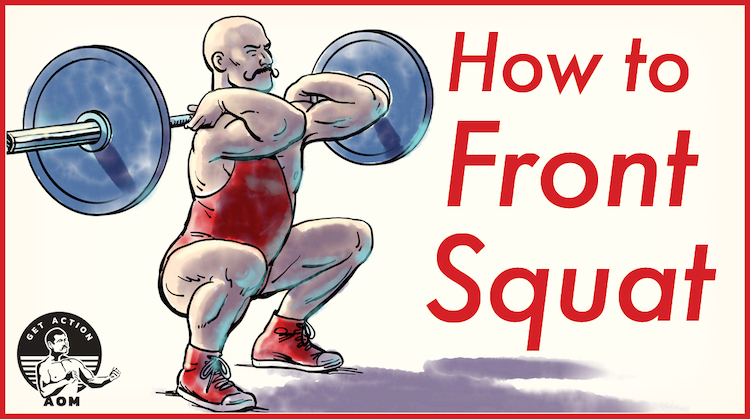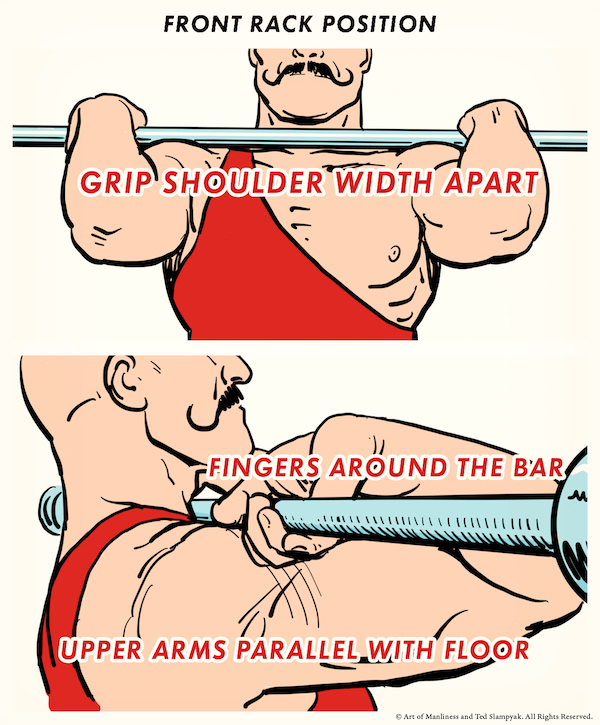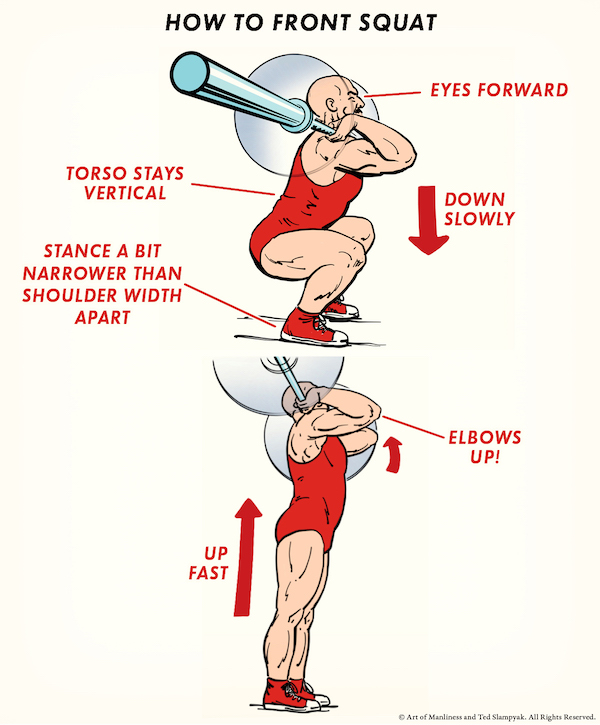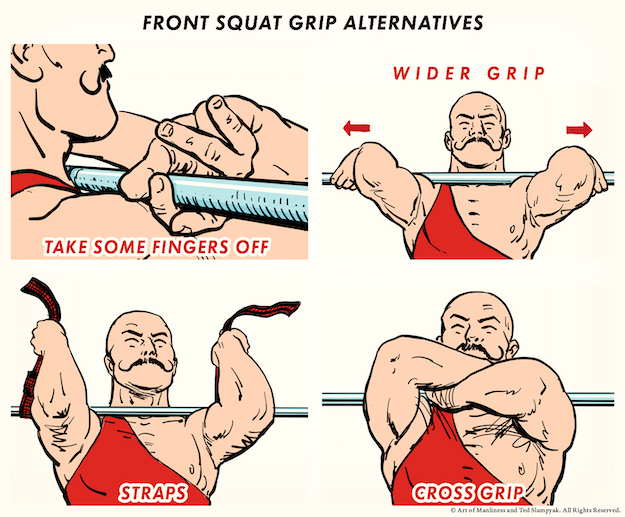
We’re big proponents of squatting here at AoM — particularly the low-bar squat. The mechanics of the low-bar squat allow you to work more muscles in your posterior chain, i.e., the “chain” of muscles that run up the back of the body. More muscle utilization = more weight moved.
But there are other ways to squat that can provide similar benefits to the low-bar squat. For example, many people do the high-bar squat, which is similar to the low-bar squat, except the bar is held higher on the back.
There’s another variation of the barbell squat that you might try incorporating into your workouts too: the front squat.
Below we dive into why and how to front squat for lower body gainz.
What Muscles Get Worked in the Front Squat?
The front squat works similar muscles as the back squat. However, due to the mechanics of the front squat, it works the quads and the glutes more. Be prepared to have some sore quads and buttisimo muscles after trying front squats for the first time. (Here’s how to deal with this soreness.)
Why Should I Front Squat?
You want to get better at the barbell clean. When you do the clean, you perform a front squat to get out of the bottom of this Olympic lift. So if you want to get better at rising up from the bottom of the clean, you’ve got to incorporate front squats into your programming.
You want a supplemental lower body lift. If you’re an advanced barbell lifter, chances are your programming will have you doing supplemental lifts. Supplemental lifts are similar to the main lifts but done a little differently in order to work the muscles you use in the main lift from a different angle. For example, rack pulls can be a supplemental lift to the deadlift.
A great supplemental lift to the low-bar squat is the front squat. While the low-bar squat works the hamstrings and hips more than the front squat, the front squat works the quads and glutes more than the low-bar squat. Similar movements, but each gives greater/lesser emphasis to certain muscle groups.
You can’t low-bar squat. Thanks to injuries, some people just can’t low-bar squat. For example, some individuals with hip issues find the hip-heavy low-bar squat incredibly painful to do. Because the front squat doesn’t require you to bend your hips, it allows people with hip issues to get the lower body benefits of squats without the pain.
And while the front squat requires you to bend your knees significantly more than you do on the low-bar squat, studies have shown that the front squat actually puts less pressure on the knees than the low-bar squat, which has led one group of researchers to conclude that “front squats may be advantageous compared with back squats for individuals with knee problems such as meniscus tears, and for long-term joint health.”
So if you’ve had trouble doing low-bar or high-bar back squats, try doing front squats.
How to Front Squat
The Set-Up & Grip

As the name suggests, unlike the back squat that has the barbell sitting on your back in either a high or low position, the front squat is going to have the barbell sitting on the front of your body, specifically across the front deltoids.
The goal of the set-up and grip on the front squat is to make a nice, sturdy meat shelf of your front delts so that the bar can rest across it while you squat. Here’s how to make this trusty meat shelf:
Take a grip on the barbell that’s about shoulder-width apart. Wrap your thumbs around the bar.
Step close to the bar and throw your elbows forward. You’re aiming to throw your elbows so far forward that your upper arms are nearly parallel to the floor. The higher the elbows are, the more muscle mass your deltoids create to form the shelf that the barbell will rest on.
Stand up straight and lift the barbell out of the j-hooks. Bam. You’re in the starting position for the front squat. Also known as the “front rack position.”
Front Squat Grip Alternatives
The standard front squat grip with thumbs and fingers around the barbell requires a significant amount of wrist mobility. If you don’t have that mobility yet, here are a few alternative grips to try:
Take some fingers off the bar. Try unwrapping your pinky and ring finger from around the bar and just hold it with your pointer, middle finger, and thumb. The bar will be pretty secure on that meaty front deltoid shelf, so you don’t need all of your fingers to keep the bar in place.
Take a wider grip. If you have a shorter humerus and a longer forearm, you’ll lack the wrist flexibility needed to take the shoulder-width apart grip on the front squat. So just take a wider grip.
Use straps. If you have lifting straps, you can use them to grip the bar. Simply wrap them around the barbell. Grasp the straps and throw your elbows forward.
Use a cross grip. This is another good option if you can’t grip the bar in a front rack position. Cross your arms and step under the bar. Place the barbell in the webbing between your thumbs and the rest of your fingers. The barbell should still be resting primarily on the front of your shoulders, and your thumbs are just kinda holding it in place. Lift elbows up so that your upper arms are parallel to the floor. Stand up straight.
Doing the Front Squat

After you’ve got the bar in the front rack position, it’s time to squat.
Stance. Take a stance that’s a bit narrower than shoulder width apart, with toes pointed slightly out.
Think “keep elbows up” to keep your torso vertical. Unlike the low-bar squat that has you bending your torso over, you want to keep your upper body upright throughout the descent of the front squat. To do that, simply think “keep elbows up.” (If you notice that you’re bending forward a bit during the ascent of the front squat, think about your elbows coming up first by remembering the cue: “lead with the elbows.”)
Another cue is to keep your eyes looking directly forward.
Take a big breath, sit back, shove knees out, and slowly squat to slightly below parallel. Remember to keep the torso vertical during the descent by thinking, “keep elbows up.”
Go up fast. The eccentric part of the front bar squat should be fast. Explode!
Don’t strangle yourself! The barbell will be resting pretty close to your throat. Be careful that you don’t let it press too hard against your throat lest you risk cutting off blood supply to your brain, which can result in fainting and passing out. No bueno.
Programming the Front Squat
As mentioned above, the front squat is typically used as a supplemental lift to a regular squat. Some individuals who can’t low-bar and high-bar squat use the front squat as their sole squatting movement.
My barbell coach, Matt Reynolds, likes to program the front squat in sets of 3 reps. To get volume, he’ll just add sets. So if you want to get 15 total reps of a front squat, you’d program 5 sets of 3 reps.
Illustrations by Ted Slampyak
The post Why and How to Front Squat appeared first on The Art of Manliness.

0 Commentaires